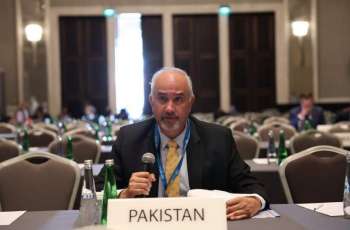MOSCOW (Pakistan Point News / Sputnik - 23rd May, 2020) The United States announced on Thursday it was leaving the Open Skies Treaty in six months.
The multilateral international Open Skies Treaty, developed with the active participation of Russia, is an arms control pact that allows for unarmed aerial surveillance flights over the territories of the 34 party states aimed at building confidence and ensuring security.
Along with the Conventional Armed Forces in Europe (CFE) Treaty and the Vienna Document, the entry into force of the Open Skies Treaty has practically completed the formation of a regime of confidence and transparency building in the field of conventional weapons in the Euro-Atlantic region.
The treaty was signed was signed on March 24, 1992, in the Finnish capital of Helsinki by 27 member states of the Conference on Security and Co-operation in Europe (CSCE, which was transformed into the Organization for Security and Co-operation in Europe, OSCE, in 1995). It entered into force on January 1, 2002. The depository states are Hungary and Canada.
As of now, 34 countries are parties to the agreement, namely Belarus, Belgium, Bosnia and Herzegovina, Bulgaria, Canada, Croatia, the Czech Republic, Denmark, Estonia, Finland, France, Georgia, Germany, Greece, Hungary, Iceland, Italy, Latvia, Lithuania, Luxembourg, the Netherlands, Norway, Poland , Portugal, Romania, Russia, Slovakia, Slovenia, Spain, Sweden, Turkey, Ukraine, the United Kingdom and the United States. The agreement is open for accession by other states, including non-OSCE countries, and allows the creation of groups of states. Thus, Russia and Belarus make one group, the other one is formed by Belgium, the Netherlands and Luxembourg.
The Open Skies Consultative Commission is the implementing body for the treaty, decisions of which are taken by consensus and are binding.
The Open Skies Treaty has proved itself as a useful tool for building confidence in the military field. It enables the participating states to fly over each other's territories in accordance with the agreed quotas of observation missions. It also regulates the conduct of flights, determines the mechanism for monitoring its compliance, contains requirements for observation aircraft, restrictions on the composition and technical parameters of observation equipment.
Every state party to the treaty has the right to allocate one or more types or models of unarmed aircraft for conducting surveillance. At the same time, the observation aircraft undergoes a survey in order to confirm that the aircraft and its observation equipment comply with the requirements. The NATO member states do not perform observation flights over each other's territories.
In addition, each state party to the treaty is able to purchase materials obtained during any observation flights under the contract.
Each state also has the opportunity to use the set of surveillance equipment envisaged by the contract from the following categories: optical panoramic and framing cameras, real-time video cameras, side-view radars with synthesized aperture, infrared imaging devices. Each category of monitoring equipment has spatial resolution limits on the ground. Currently, only the first two categories are used.
Russia uses such aircraft as the An-30B, Tu-154M LK and Tu-214 OH, while the United States uses the Boeing OC-135B Open Skies for these flights. It is possible to use aircraft belonging to the observed side for such flights.
While conducting an observation flight, representatives of the country over which the flight is taking place are always on board the aircraft. The flight is carried out from a specific airfield. In Russia, such airfields are located in Kubinka (Moscow region), Ulan-Ude, Magadan and Vorkuta (the Republic of Komi).
Since 2017, the United States began to tighten its approach. Since January 1, 2018, Washington introduced the following restrictive measures against Moscow: refusal to grant permission to bend the US air traffic rules and aviation safety standards (restricting flights at low altitudes in uncontrolled airspace, as well as banning flights below 5,500 meters in the area of the city is Washington); a change in the special procedure for performing observation flights over the Hawaiian Islands by limiting the maximum range of flights from Hickam air base to 900 kilometers, as Hawaii is located outside the 600-kilometer zone from the main territory of the country; refusal to provide overnight stays on the continental part of the United States (Robbins, Georgia, and Ellsworth, South Dakota air bases), in connection with which Russian observation planes will be forced to make longer flights to return to the start and end points of the missions. Observers from Russia are allowed to spe
nd the night only at the start and end air bases (Wright Patterson, Ohio, McConnell, Kansas, and Travis, California).
In addition, Washington has introduced limits on observation flights over the territory of Aleutian Islands.
In response, Moscow made the coordination of overnight stays at three refueling airfields necessary, and also announced the termination of a number of bilateral technical agreements and unilateral measures that had been applied in good faith and facilitated earlier US missions over Russia.
In 2018, observation flights within the framework of the treaty were not carried out, as Georgia blocked the decision of the UN Security Council on the allocation of flight quotas, which included a mission over its territory. When discussing quotas for 2018, the Russian Federation also announced a flight over Georgia. However, the Georgian authorities refused to accept the Russian mission. Tbilisi was indignant at the fact that, for a long time, Russia did not allow flights over a 10-kilometer zone from the borders of South Ossetia and Abkhazia. Moscow referred to a provision of the treaty according to which flights are prohibited in the border zone of states that are not parties to the treaty. The disagreements of the parties are related to the fact that Moscow recognizes South Ossetia and Abkhazia as independent states, and Tbilisi does not.
While allocating quotas for 2019, Russia excluded a flight over Georgia from its application. As a result, in October 2018, the distribution of observation flight quotas was approved, and then the full-scale missions were resumed. In total, in 2019 Russia carried out 42 observation flights over other participating states and received 29 others over its territory.
In early October 2019, Chairman on the US House Foreign Affairs Committee Eliot Engel mentioned that the White House was "exploring" the possibility of withdrawing from the treaty and opposed the idea. Shortly after, the Wall Street Journal reported, citing sources, that US President Donald Trump had already signed a document outlining the intention of the US administration to withdraw from the treaty. At the same time, according to the publication, the decision is not final and consultations are ongoing.
Vladimir Ermakov, the head of the Russian Foreign Ministry's Department for Nonproliferation and Arms Control, said Moscow would be forced to retaliate if the United States decided to withdraw from the treaty, and attempts to blame Russia for breaching the treaty did not hold up against criticism.
On May 21, 2020, Trump said the the US would leave the Open Skies Treaty due to alleged violations by Russia. In response, Russian Deputy Foreign Minister Alexander Grushko said that there were no breaches of the treaty by Moscow, adding that all the issues that the United States raises can be discussed in the framework of the Open Skies Consultative Commission. The diplomat noted that Moscow had issues with Washington regarding the implementation of this agreement.



